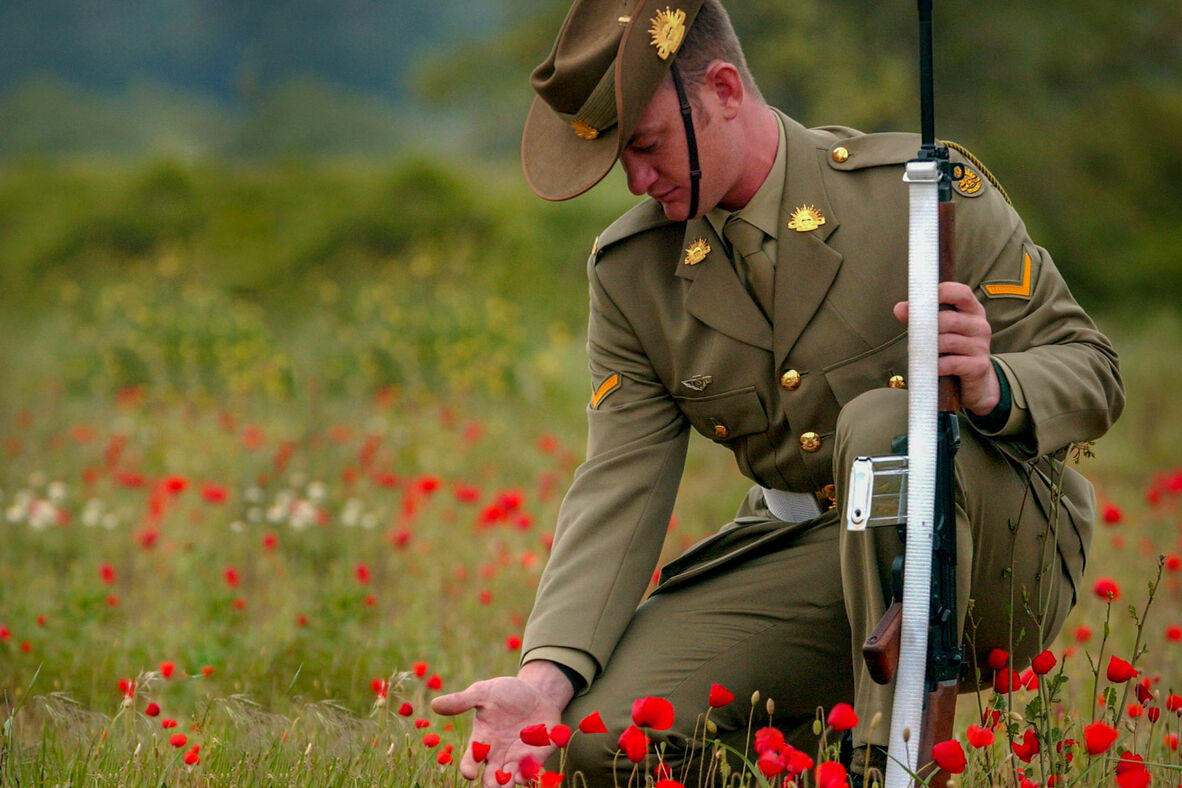Make a poppy pinwheel at Anzac Square Memorial Galleries this school holidays!
By Greg Corbett, Engagement Officer, Anzac Square Memorial Galleries | 13 December 2024
A poppy pinwheel at the Anzac Square Wall. Photo by Anzac Square staff member.
Visit Anzac Square Memorial Galleries these school holidays to make a poppy pinwheel and discover the significance of poppies.
Poppies have been associated with war as far back as the Napoleonic wars (1803-1815), when a writer noticed a field of poppies growing over soldiers' graves. A resilient flower, the red poppy was amongst the first to return to bloom in the fields of France and Belgium after World War I, emerging as a symbol of remembrance for the Allied soldiers who fell in battle.
Poppies in the Anzac Square WWI Gallery, 20 September 2022, PixelFrame, Corporate Image Library
Canadian doctor, teacher and soldier John McCrae was inspired to write the poem 'In Flanders Fields' after the death of a friend at the second battle of Ypres in 1915.
In Flanders Fields by John McCrae
In Flanders fields the poppies blow
Between the crosses, row on row,
That mark our place; and in the sky
The larks, still bravely singing, fly
Scarce heard amid the guns below.
We are the Dead. Short days ago
We lived, felt dawn, saw sunset glow,
Loved and were loved, and now we lie,
In Flanders fields.
Take up our quarrel with the foe:
To you from failing hands we throw
The torch; be yours to hold it high.
If ye break faith with us who die
We shall not sleep, though poppies grow
In Flanders fields.
This poem inspired American War Secretary Moina Michael, who sold poppies to raise money for servicemen in need after World War I, and this began a tradition of poppies for remembrance.

Lance Bombardier Greg Meller picks a poppy following the Anzac Day Dawn Service at Gallipoli, 2004. John Oxley Library, State Library of Queensland Image No: 31926-0001-0082.
According to the Australian Army, 'Australians wear a red poppy on Remembrance Day for three reasons:
- in memory of the sacred dead who rest in Flanders fields.
- to keep alive the memories of the sacred cause for which they laid down their lives.
- as a bond of esteem and affection between the soldiers of all Allied nations and in respect for France, our common battleground.' (Australian Army, n.d.)
A poppy pinwheel in the Post World War II Gallery. Photo by Anzac Square staff member.
Visit our Post World War II Memorial and Exhibition Gallery 10am to 4pm between Sunday 15 December 2024 and Sunday 26 January 2025 and, on our craft table, you'll find everything you need to make your very own poppy pinwheel.
Family at the Anzac Square Wall, 20 September 2022, PixelFrame, Corporate Image Library
Once you've succeeded in making your poppy spin, stay to explore the Memorial Galleries, embarking on an interactive journey from the First World War to today, before taking time to reflect on the remarkable stories of bravery and sacrifice in the tranquil parklands.
References
‘11 things you might not know about the poppy’, n.d., Royal British Legion, viewed 11 December 2024, https://www.britishlegion.org.uk/stories/11-things-you-might-not-know-about-the-poppy
‘The red poppy’, n.d., Australian Army, viewed 11 December 2024, https://www.army.gov.au/about-us/history-and-research/traditions/red-poppy
‘In Flanders Fields...’, n.d., KU Medical Center, The University of Kansas, viewed 11 December 2024, https://www.kumc.edu/school-of-medicine/academics/departments/history-and-philosophy-of-medicine/archives/wwi/essays/medicine/in-flanders-fields.html
‘Where did the idea to sell poppies come from?’ Friday 10 November 2006, BBC News, viewed 11 December 2024, http://news.bbc.co.uk/2/hi/uk_news/magazine/6133312.stm
‘Remembrance Day: Lest we forget’, 7 November 2008, CBC News, viewed 11 December 2024, https://www.cbc.ca/news/canada/remembrance-day-lest-we-forget-1.725730
Comments
Your email address will not be published.
We welcome relevant, respectful comments.